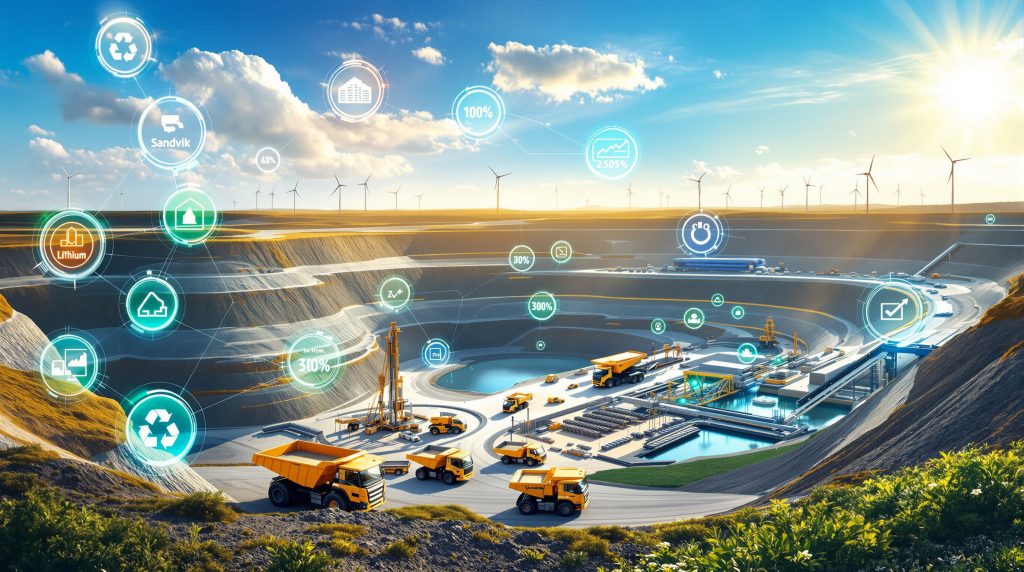Revolutionizing Extraction: Modern Mining's Environmental Evolution
Sandvik sustainable mining practices represent a fundamental shift in how the industry approaches environmental responsibility while meeting growing global mineral demand. Mining operations worldwide face mounting pressure to minimise environmental impact through innovative technologies and operational methodologies. Contemporary extraction processes must balance productivity requirements with ecological stewardship, creating unprecedented opportunities for technological advancement.
Furthermore, the transition towards cleaner mining practices involves comprehensive equipment modernisation and process optimisation. Industry leaders recognise that sustainable operations deliver long-term competitive advantages whilst addressing regulatory compliance requirements effectively.
Electric Power: Driving Sustainable Mining Forward
Battery-Electric Vehicle Integration
Contemporary mining facilities increasingly embrace battery-powered equipment to eliminate underground diesel emissions completely. The implementation of electric vehicles in mining reduces ventilation requirements by approximately 50%, substantially decreasing operational energy consumption whilst enhancing air quality conditions for workers.
Electric mining vehicles operate with zero emissions at the point of use, creating safer working environments. This transformation enables mines to operate more efficiently whilst protecting worker health and reducing overall environmental impact significantly.
Cable-Electric Machinery Benefits
Modern cable-electric systems deliver multiple advantages over traditional diesel alternatives through advanced engineering solutions:
• Immediate emission reduction at point of use eliminates harmful particulates
• Lower operating temperatures extend equipment lifespan by 25-30%
• Reduced maintenance costs through simplified mechanical systems
• Enhanced productivity through consistent power delivery without fuel interruptions
Technology Integration for Circular Mining
Advanced Recycling Systems
Leading mining equipment manufacturers implement comprehensive material recovery programs targeting over 90% circularity rates. The sophisticated battery recycling process recovers valuable tungsten materials, reducing raw material dependency by significant margins whilst establishing sustainable supply chains.
These recycling initiatives extend beyond simple material recovery, incorporating sophisticated refurbishment processes. The circular approach minimises waste streams whilst maintaining operational efficiency across mining operations through systematic resource management.
Equipment Refurbishment Programs
| Process Stage | Environmental Benefit | Cost Reduction |
|---|---|---|
| Component Recovery | 75% material reuse | 40-60% savings |
| Precision Remanufacturing | 80% emission reduction | 30-50% savings |
| Performance Restoration | Extended operational life | 25-35% savings |
Digital Solutions Optimising Resource Efficiency
Automation Technology Impact
Automated mining systems eliminate human error whilst maximising extraction efficiency through precise control mechanisms. The integration of AI in mining efficiency processes real-time geological data to optimise drilling patterns, reducing waste rock generation by up to 30%.
Advanced automation integrates machine learning algorithms that continuously adapt to changing geological conditions. This technological evolution represents a significant advancement in mining precision and environmental stewardship through intelligent resource management.
Predictive Analytics Applications
Modern predictive analytics platforms deliver comprehensive operational optimisation across multiple operational parameters:
• Equipment maintenance scheduling prevents unnecessary downtime and reduces emergency repairs
• Resource allocation optimisation minimises energy waste through intelligent distribution
• Production forecasting enables efficient supply chain management and inventory control
• Safety monitoring systems reduce accident-related environmental damage and worker injuries
Measuring Sustainable Mining Success
Emission Reduction Targets
Leading mining technology providers commit to 50% greenhouse gas emission reductions by 2030, with net-zero targets by 2050. These ambitious benchmarks drive innovation across equipment design and operational processes whilst establishing industry standards for environmental performance.
The commitment extends beyond equipment manufacturers to encompass entire mining operations. This creates comprehensive sustainability frameworks that address every aspect of mineral extraction and processing through systematic implementation.
Energy Efficiency Improvements
Modern mining equipment achieves 20-40% better energy efficiency compared to conventional alternatives, translating to substantial operational cost savings and environmental benefits across global operations.
However, achieving these efficiency gains requires careful planning and strategic investment in advanced technologies. Moreover, companies must consider long-term operational benefits when evaluating sustainable mining solutions.
Supporting Global Energy Transition Through Mining
Critical Mineral Demand Growth
The renewable energy sector requires unprecedented quantities of lithium, copper, and nickel for battery production, wind turbines, and solar installations. Electric vehicles require six times more mineral inputs than conventional vehicles, whilst onshore wind plants need nine times more mineral resources than gas-fired power plants.
Meeting net-zero goals by 2050 requires five times current production levels for key battery minerals. Consequently, this underscores mining's essential role in environmental protection without compromising extraction capacity through strategic planning.
Supply Chain Responsibility
Mining companies increasingly adopt comprehensive sustainability frameworks covering multiple operational aspects through systematic implementation:
• Water management systems reducing consumption by 30-50% through recycling and efficiency measures
• Waste minimisation protocols achieving 85%+ material recovery through advanced processing
• Biodiversity protection measures preserving ecosystem integrity around mining sites
• Community engagement programs ensuring social licence to operate through transparent communication
Furthermore, Sandvik's mining solutions demonstrate how industry leaders integrate sustainable practices into operational frameworks effectively.
Innovation Shaping Mining's Future
Autonomous Equipment Development
Next-generation mining vehicles operate with minimal human intervention, optimising fuel consumption and reducing safety risks through sophisticated control systems. These platforms integrate advanced machine learning algorithms to continuously improve operational efficiency whilst adapting to changing environmental conditions.
Autonomous systems represent the convergence of multiple technologies, including GPS navigation, sensor arrays, and artificial intelligence. In addition, these systems create mining operations that function with unprecedented precision and environmental awareness.
Smart Monitoring Networks
Real-time environmental monitoring systems enable immediate response to potential issues, preventing minor incidents from escalating. These networks integrate multiple sensor technologies to provide comprehensive oversight of air quality, water systems, and soil conditions effectively.
For instance, modern monitoring systems can detect environmental anomalies within minutes, enabling rapid corrective action before significant damage occurs.
Mining's Essential Role in Renewable Energy Infrastructure
Material Requirements Analysis
The transition to renewable energy creates massive demand for specific minerals essential to clean technology manufacturing. Electric vehicle batteries require substantial lithium, nickel, and cobalt quantities, whilst wind turbine construction depends heavily on rare earth elements.
This reality underscores mining's critical role in environmental protection, as renewable energy infrastructure cannot exist without reliable access. The battery metals investment landscape continues evolving to meet these growing demands effectively.
Future Production Scaling
Achieving 2050 net-zero targets requires extraordinary increases in mineral production capacity. Current extraction levels must expand dramatically to support global renewable energy deployment whilst maintaining environmental standards through innovative approaches.
The sustainable mining transformation involves comprehensive operational changes across multiple industry sectors to achieve these ambitious targets.
Implementation Roadmap for Mining Companies
Technology Integration Strategy
Successful Sandvik sustainable mining implementation follows a structured approach through systematic planning and execution:
- Assessment Phase: Evaluate current equipment efficiency and emission profiles through comprehensive auditing
- Planning Stage: Develop electrification timeline with infrastructure requirements and budget allocation
- Implementation Process: Deploy automated systems with comprehensive training programs for operational staff
- Monitoring Framework: Establish performance metrics and continuous improvement protocols for ongoing optimisation
Investment Considerations
Sustainable mining technology requires significant upfront investment but delivers long-term operational savings through reduced energy costs. The financial benefits compound over time as equipment longevity increases and maintenance requirements decrease substantially.
Companies must consider total cost of ownership rather than initial capital expenditure when evaluating sustainable mining technologies. Operational savings often exceed implementation costs within five to seven years through efficiency improvements.
Future Trends in Sustainable Mining
Emerging Technology Developments
Advanced materials science enables lighter, more durable equipment components whilst artificial intelligence optimises extraction processes in real-time. These developments promise further environmental impact reductions alongside productivity improvements through continuous technological evolution.
Research into battery technology, autonomous systems, and precision drilling continues advancing rapidly. Consequently, this creates opportunities for even greater sustainability achievements in coming decades through systematic innovation.
Global Policy Alignment
International environmental regulations increasingly favour sustainable mining practices, creating competitive advantages for early adopters. Government incentives and regulatory frameworks support companies investing in clean technology and sustainable practices effectively.
The regulatory environment continues evolving toward stricter environmental standards, making Sandvik sustainable mining practices economically essential for long-term viability. Moreover, sustainability initiatives in mining demonstrate the industry's commitment to environmental stewardship.
Disclaimer: This article contains forward-looking statements regarding mining technology developments and regulatory changes. Actual results may vary based on market conditions, technological advancement rates, and policy implementations. Companies should conduct thorough due diligence before making investment decisions based on projected industry trends.
Ready to Capitalise on the Next Major Mineral Discovery?
Discovery Alert's proprietary Discovery IQ model delivers real-time notifications on significant ASX mineral discoveries, instantly empowering subscribers to identify actionable opportunities ahead of the broader market. Understand why historic discoveries can generate substantial returns by exploring Discovery Alert's dedicated discoveries page, showcasing exceptional outcomes from major finds, and begin your 30-day free trial today to position yourself ahead of the market.




